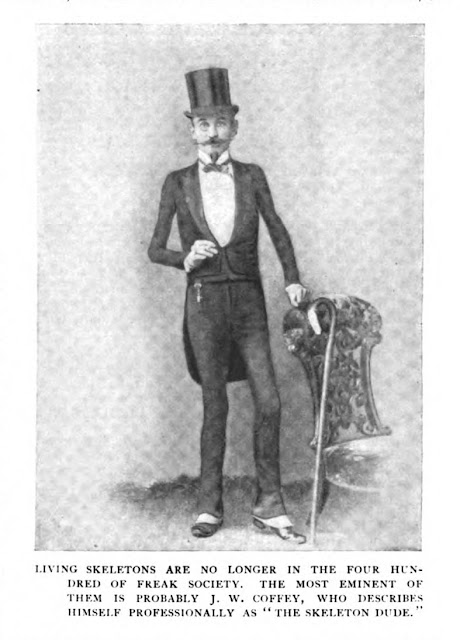The “Skeleton
Dude”
John W. Coffey, the “Skeleton Dude,” began
his career as a run-of-the-mill, “thin man” sideshow act under the stage-name,
the “Ohio Skeleton,” in about 1885. He
rose to greater fame after affecting the distinctive dress and mannerisms of a typical
“Dude,” adopting the title “Duke of Tuxedo,” and taking the stage name, the “Skeleton
Dude.” The stereotypical “Dude” of the day was frequently said to have “toothpick
legs” and a generally weak physique, so the persona fit perfectly with his
physical traits.
The skeleton dude owns large estates in Portugal or
somewhere, and his proper title is the Duke of Tuxedo. At least so his manager says, and of course
it must be true. The “Dook” is a native
of Ohio, and his name at home is John Coffey.
He is a skeleton by nature and a dude by profession. He differs from other dukes in one respect –
that is, in the matter of brains, John has some. Living skeletons were at a discount when John
started as a freak. One day he was
reading the Analytical Psychologist,
or some comic paper of that kind, and he saw a picture of a dude – a caricature
– with pipe-stem legs and attenuated frame, and he slapped his thigh bone and
shouted “Eureka.” Three days later, Mr.
Coffey made his debut in a Cincinnati museum as “the Duke of Tuxedo, the
Skeleton Dude.” The bills announced that
the Duke had come over to this country to look for a wife, and that any nice
girl who would agree to overlook his attenuity of frame might have his hand in
marriage and half his estates in Portugal.
The bills didn’t say anything about Mrs. Coffey and the five little
Coffey beans in the little Ohio village, where John used to work as a painter
and paper hanger before muscular atrophy took the flesh off his bones and made
him a freak.
The Chicago Tribune, November 27, 1887, page 25.
He toured Europe with P. T. Barnum in
1889. An artist for a London
newspaper depicted the “Skeleton Dude” sitting between the “fat baby” and the “giant cowboy,” doffing his
hat toward the “fair lady who wears ‘the Anaconda necklace.’”
 |
The Graphic
(London), November 30, 1889, page 665.
|
A British reviewer described his only
joke, which played off his image as a flirtatious “Dude” or “masher.”
“The ‘Skeleton Dude,’ with the bodily weight of a baby and
the manners of Sir Charles Grandison, whose single joke is to ask his fair
admirers whether they would like to see his sweetheart, and then to show them a
looking glass.
The Graphic
(London), November 30, 1889, page 666.
Although married,[i]
Coffey’s character presented himself as a “masher,” on the prowl for a new
sweetheart; even placing personal ads in local newspapers before appearances in
the town.
 |
The Pittsburgh Press, February 15, 1888, page 8.
|
On occasion, he took part in mock-weddings;
sometimes with relatively normal women, and sometimes to a fellow sideshow “freak”
of dramatically contrasting size.
 |
The Boston Globe, January 27, 1887, page 2.
|
Coffey and his Fat Bride . . .
The Skeleton Dude . . . He Weighs 56 Pounds (Just After His
Dinner.) . . .
Married in New York . . . to the Fair and Robust
Gertie Platt . . .
Gertie Weighs 556 Pounds!
The Boston Globe, March 31, 1895, page 19.
Sometimes a former “bride” (or two or
three or four) would make a dramatic return with objections to the new “marriage.”
The Sunday Truth (Buffalo, New York), July 20, 1890, page 8 (small dogs were also
frequently associated with stereotypical “Dudes”).
 | |
| The “Skeleton Dude” with a “skeleton key” hanging from his belt. The Illustrated American, Volume 4, Number 38, November 8, 1890, page 368. |
[i] “John
Coffey – The Living Skeleton Dude,” Candy Guy, TheHumanMarvels.com,
https://www.thehumanmarvels.com/john-coffey-the-living-skeleton-dude/













